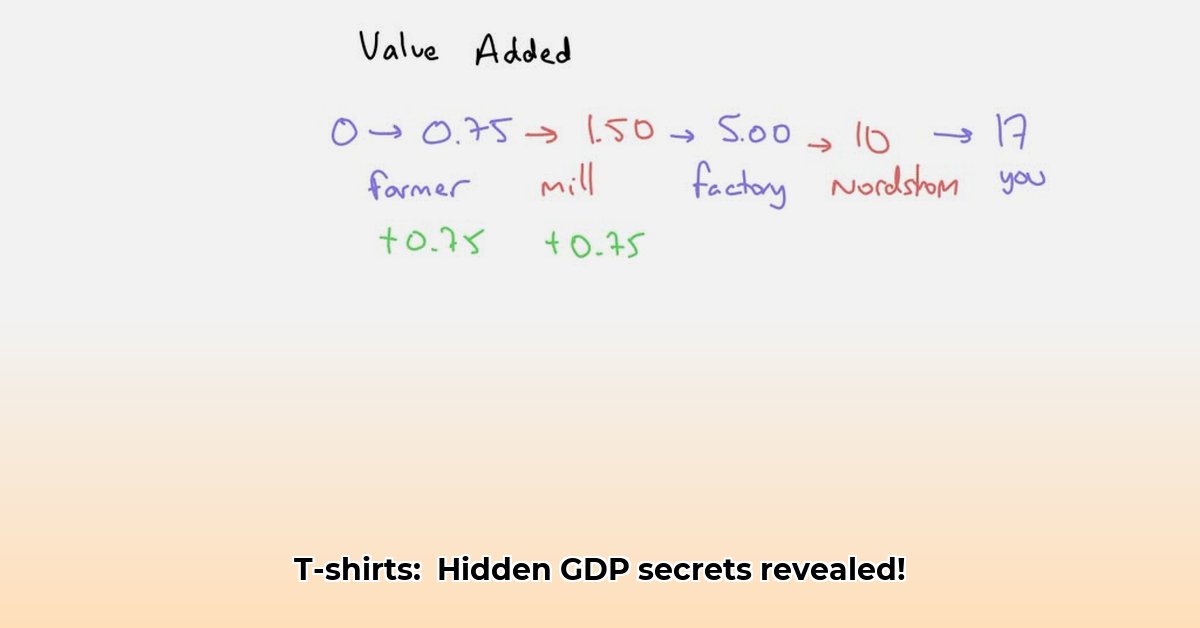
Consider an Economy Which Produces and Sells: Unpacking the Hidden Value in a Simple T-Shirt
We often overlook the complex economic journey of everyday items. Take a simple t-shirt: its production, from cotton field to retail store, reveals a fundamental macroeconomic concept: the value-added approach to calculating Gross Domestic Product (GDP). This approach focuses not just on the final sale price, but on the incremental value added at each stage of production. Understanding this process is key to grasping how economists measure economic activity and its complexities.
How much do you think a simple t-shirt contributes to a nation's economy? More than you might initially imagine. Its seemingly simple journey encapsulates the core principle of value-added GDP calculation.
The T-Shirt's Amazing Journey: A Value-Added Adventure
Let's trace a $20 t-shirt's journey, breaking down the value added at each stage:
Cotton Farming: The farmer's contribution – including labor, seeds, fertilizer, and land rent – adds, let's say, $2 to the t-shirt's value. This initial value creation sets the stage for the entire production process.
Cotton Milling: Processing the raw cotton into yarn adds another $3 in value. This encompasses machinery costs, energy, and worker wages. This step transforms the raw material into a more refined product, increasing its economic worth.
Shirt Manufacturing: Transforming the yarn into a finished t-shirt is the most labor-intensive phase, adding approximately $8 worth of value. This covers the factory's operating costs, seamstresses' wages, and machine costs. This stage significantly increases the product's value through skilled labor and manufacturing processes.
Wholesaling: The wholesaler's role – storage, transportation, and packaging – adds about $4, reflecting their profit margin for handling and distribution. This contribution highlights the crucial role of efficient distribution networks.
Retail: The final sale adds another $3, covering retail expenses such as rent, staff wages, and electricity. This final value-added step brings the product to the end consumer.
| Stage | Value Added ($) | Description |
|---|---|---|
| Cotton Farming | 2 | Growing and harvesting cotton |
| Cotton Milling | 3 | Processing cotton into yarn |
| Shirt Manufacturing | 8 | Transforming yarn into a finished t-shirt |
| Wholesaling | 4 | Bulk distribution and preparation for retail |
| Retail | 3 | Storage, display, and final sale to the consumer |
| Total Value Added | 20 | The sum of all value added at each stage in the production chain. |
This demonstrates that the final $20 price reflects the cumulative value generated throughout the entire production chain. This total constitutes the t-shirt's contribution to the nation's GDP via the value-added method.
More Than Just Dollars and Cents: The Bigger Picture
While the value-added method provides a useful framework, it has limitations. Critically, it often omits crucial factors such as:
Environmental Costs: The water used in cotton farming, energy consumed in factories, and waste generated throughout the process contribute significantly to the overall environmental cost. These are external costs not typically reflected in the price.
Social Costs: Fair wages, safe working conditions, and ethical sourcing are vital considerations that significantly impact the overall cost/value. Often, these factors are ignored in traditional GDP calculations.
Innovation & Branding: A unique design or a well-known brand adds significant value, although these intangible assets are difficult to quantify directly within a value-added framework.
Therefore, the true economic impact of a $20 t-shirt likely extends far beyond the sum of the value-added chain. This requires incorporating a detailed analysis of social and environmental externalities.
How to Calculate the True Economic Impact of T-Shirt Production Including Externalities
The true cost of a t-shirt far exceeds its retail price. To account for this, we delve into the concept of externalities – environmental and social costs not reflected in the market price.
Mapping the Value Chain: A Step-by-Step Approach
To calculate the full economic impact, we must assess the externalities at each stage:
Raw Material Extraction: The environmental and social costs of cotton farming—land use, pesticide use, water consumption—must be quantified.
Manufacturing: Energy consumption, waste generation, and labor conditions (fair wages, safety) are significant factors.
Transportation and Distribution: The carbon footprint of transportation and distribution needs to be evaluated.
Retail and Consumption: The environmental impact of textile waste at the end of the t-shirt's lifecycle must also be considered.
Quantifying the Unseen: Methods and Challenges
Economic valuation techniques like contingent valuation and hedonic pricing attempts to quantify these externalities. However, data limitations and the complexities of global supply chains present significant challenges.
Putting it All Together: A Holistic View
By integrating direct costs with quantified externalities, a more accurate and comprehensive understanding of a t-shirt's true economic impact emerges. This holistic approach promotes greater sustainability and social responsibility.
Towards a Sustainable Future
Greater transparency in supply chains, improved data collection, and effective valuation techniques are crucial. Consumers, businesses, and governments must collaborate towards a more sustainable future.
Key Takeaways:
- The market price only reflects a fraction of a product's true economic cost.
- Calculating true economic impact requires considering environmental and social externalities.
- Accurate valuation methods are needed, but data limitations remain.
- Comprehensive accounting promotes sustainable and socially responsible practices.
- Collaboration between consumers, businesses, and governments is vital.